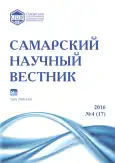Ecological-taxonomic analysis of the petrophyte flora of Ikhrek (Rutulsky district) surroundings of Republic of Dagestan
- Authors: Khalidov A.M.1
-
Affiliations:
- Dagestan State University
- Issue: Vol 5, No 4 (2016)
- Pages: 70-73
- Section: 03.02.00 – General Biology
- URL: https://journals.rcsi.science/2309-4370/article/view/22149
- DOI: https://doi.org/10.17816/snv20164113
- ID: 22149
Cite item
Full Text
Abstract
The study of petrophytes, as a peculiar group of plants, is important for understanding the history of the flora and nature in general. Their ecological characteristics, taxonomic composition, geographic and genetic relationships and other characteristics carry information about the stages of development of the mountain country and its flora. Rutulsky district is a part of Highland Dagestan and borders on the Republic of Azerbaijan in the South, Akhtynsky and Kurakhsky districts in the East, Tlyaratinsky and Charodinsky districts in the North-West, Kulinsky, Agulsky and Laksky districts of the Republic of Dagestan in the North. The relief of Highland Dagestan, which is the area of our research, is characterized by a large slope, stony and rocky mountains. The following paper contains taxonomic, biomorphic, ecological analyses of petrophyte complexes of the studied area and an analysis of endemism and relict flora of petrophytic complexes. Herbarium material has helped to find the dominant family, genera and species of petrophyte complexes of the area. Biomorphic and environmental groups of petrophyte complexes have been studied. Confinement of petrophytes to different environmental conditions has been established. Endemic, relict and protected species of petrophyte complexes have been identified.
Full Text
##article.viewOnOriginalSite##About the authors
Agarza Medzhidovich Khalidov
Dagestan State University
Author for correspondence.
Email: khalidov_99@mail.ru
candidate of biological sciences, associate professor of Botanic Department
Russian Federation, 367025, Makhachkala, M. Gadzhiev street, 43aReferences
- Гроссгейм А.А. Определитель растений Кавказа. М.: Советская наука, 1949. 747 с.
- Галушко А.И. Флора Северного Кавказа. Определитель в 3 т. Ростов-на-Дону: Изд-во РГУ, 1978-1980. Т. 1. 328 с., Т. 2. 352 с., Т. 3. 320 с.
- Raunkiaer C. Life forms of plants and statistical Рlant geography. N.Y. Landon, 1934. S. 176.
- Шихэмиров М.Г. Результаты анализа флоры Самурской долины Дагестана от моста Цахул до верховий Самура Изв. АН Азерб. ССР. 1970. № 4. С. 296.
- Шхагапсоев С.Х. К охране скально-осыпной растительности Кабардино-Балкарии. Редкие и исчезающие виды растений и животных, флористические и фаунистические комплексы Северного Кавказа, нуждающиеся в охране: Тез. докл. научн.- практ. конф. Ставрополь: СГПИ. 1986. С. 76-77.
- Теймуров А.А. Эколого-географическая и биологическая характеристика петрофитов Самурского хребта и Джуфудага в связи с историей формирования флоры Южного Дагестана: автореферат дис…канд. биол. наук. Махачкала: ДГУ, 1998. 26 с.
- Халидов А.М. Петрофиты Транссамурских высокогорий Южного Дагестана и их анализ: автореф. дис… канд. биол. наук. Махачкала: ДГУ, 2006. 24 с.
- Красная книга республики Дагестан (растения) / отв. Г.М. Абдурахманов. Махачкала, 1998. 329 с.
- Аджиева А.И. Кавказские эндемичные виды растений на территории Дагестана. Махачкала, 2008. 96 с.
- Муртузалиев Р.А., Алиев Х.У. О некоторых новых и редких видах флоры Дагестана // Ботанический журнал. 2008. Т. 93. С. 1801-1804.
Supplementary files






